Recollections of a Village by Alan Proctor
Alan Proctor was a well-known local character - once met never forgotten. He wrote the first draft of his recollections of Hawk Green in 2005 and I wanted to publish them at the time but they were (rightly) featured on the HGRA web site, so I linked to them instead. After the HGRA site went off-line in 2011, Alan asked for them to be reproduced on The Marple Website so that they can be shared with the wider community, as they should be.
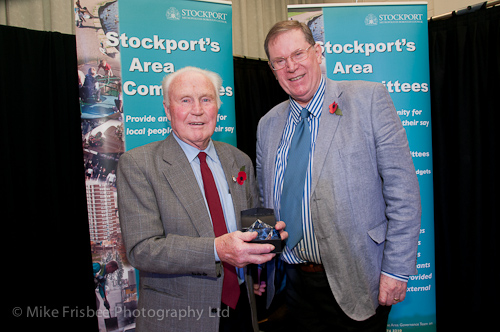
Alan with Cllr Martin Candler receiving an Environmental Champion Award.
Here's Alan's introduction, in his own words:
You don’t know what you’ve got till it's gone. I didn't appreciate the place until my later years, I simply took it for granted. Now I realise just how singular it is in many ways. Industrial, farming, golf club, cricket club, its own brass band, a fine hostelry, a post office, two chippies and many other features. And not least our proximity to some great scenery and tourist spots. Well, like many others, Joan and I will not be moving. "except," as she says, "in a box."
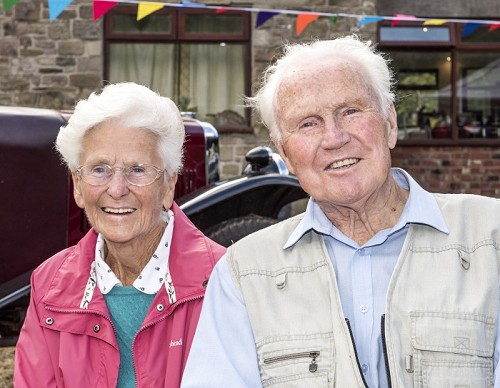
Alan and Joan Proctor Born and Bred in Hawk Green..
Recollections of a Village by Alan Proctor (first written circa 2005)
(illustrated with images from the Virtual History Tour of Marple)
with thanks to Ray Noble for many of the images used.
The word, village, is apt to describe Hawk Green as it was in my youth. To a stranger it is now indistinguishable from Marple, though we still have a cricket club, a post office and a village green to maintain the old 'Hawk Greeners' claim to individuality.
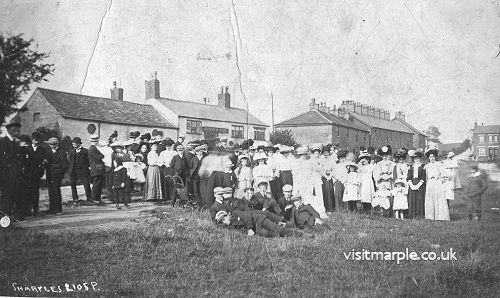
A gathering at Hawk Green pre-WW1
Prior to the 1939-45 War, there was very little building, apart from dotted development along Church Lane - Ridge Road, and Hibbert Lane leading to the village. Lyme Grove, Cynthia Drive and Waterside were the nearest streets, and there were open spaces, which are now taken up by ‘new’ developments within the village boundaries.
Facilities.
Before the advent of supermarkets, mail order and two car families, all daily needs could be found in the village. Within a small area were a newsagent and sweet shop, a greengrocer, two home bakers, a butcher with his own slaughter house, a post office, an off-licence, a co-op, a hairdresser, a blacksmith, a public house, at least three farms (providing fresh milk and cream daily) and a golf club! In addition, Rose Hill Football Club and the Cricket Club played on the village green. All we had to leave the village for was to visit a 'chemist' which we could travel to on one of two regular bus services - Marple Station to Hawk Green and Hazel Grove to Mellor, running every half hour, each with a conductor as well as the driver.
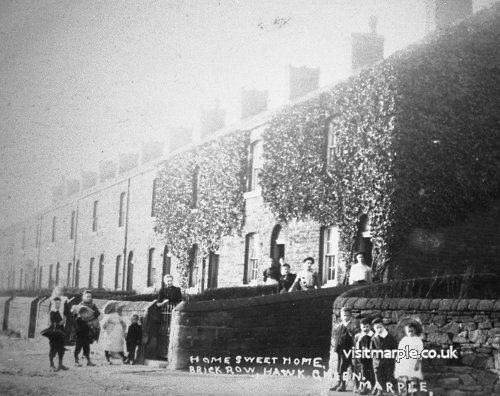
Brick Row, Hawk Green, "Home Sweet Home"
The Reading Room
The Reading Room was originally built for the use of men working at the Goyt Mill. It had baths at the back, and was used for reading newspapers and other recreational purposes.
It was left in a privately held trust. I imagine that the original idea was to help with the education of the working class as that provision was a haphazard affair in the early years of the Century. It was a laudable project, which was run by a committee and trustees who oversaw good order, and it provided a meeting place for various groups.
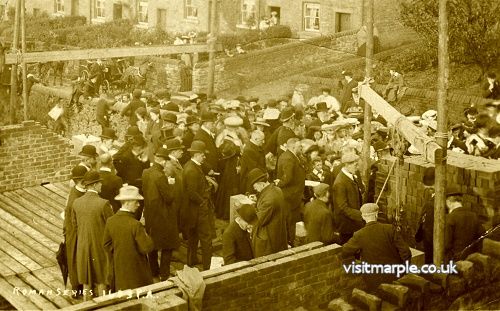
Laying of the foundation stones for Hawk Green Reading Rooms in 1906.
There were two snooker tables and a small back room with a reading desk, a large table and chairs where the 'wrinklies' could play dominoes for pennies (a gambling den!). The title Reading Room referred to the daily evening paper, which was delivered for the more frugal members to read. The magazine, Punch, was also provided monthly, though one suspects that that venerable mouthpiece of the chattering classes was a little too obscure for some of the local worthies! There is a ban on alcohol, as the pious founders probably foresaw the dangers of such self-indulgence. The Women's ‘Bright Hour’ still meet there, though they no longer sing, accompanied by the harmonium.
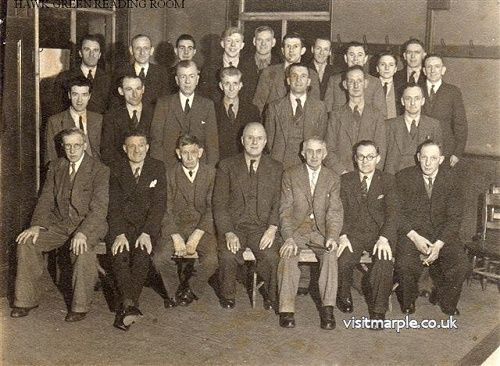
A group of gentlemen in the Hawk Green reading Rooms around 1945.
In the Reading Room there hung a large framed portrait (photograph of a handsome uniformed Army Officer complete with moustache and 'Sam Browne' (leather adornment). I often wondered who this could be and what could be his connection to the Hall. Well it transpired that he was a Lieutenant Barlow from 'Woodville' (House) who died in the 1914-18 War. The family who lived for many years as local monied Gentry in the splendid Victorian 'Pile' were involved in local affairs, giving their support (and name) to various groups, though how much 'finance' is unknown. The classically framed picture was sold to a local man, Cliff Hill with the tag, “Frame £3.00!!” during a clear out by a newly formed Committee. No mention of its provenance! However, upon reading a 'Village Recollections' in 1999 Cliff approached me saying that he thought he might have the said picture. Sure enough it was the Missing Treasure. A local piece of history, which might well have been lost. A further example of why we must strive to save memories and artefacts for our successors.
We now know that Lt. Barlow was a navigator/gunner shot down in France by Baron Von Richtofen, The Red Baron, a famous but tragic connection. The picture is now in Marple Library.

Harold Carver-Barlow's card from the WWI Timeline in Memorial Park
Lt. Barlow had a sister, who of course lived at Woodville, until near her death in the late sixties, when the house, now sadly demolished, became a Care Home, to be replaced by the now all too common “Functional Building”, also a Residential Care Home called Arbour Court (Buxton Lane).
Miss Barlow was the Hawk Green Cricket Club's President for many years and there is a photo of her tossing a coin prior to the official opening of the new ground in 1960 with the late Roy Hallas and Mike Simpson, captains on the day. In fact she opened the Original Pavilion on the Green, a picture of which can still be seen, surrounded as she is by 10 players (Who's missing?) and officials.
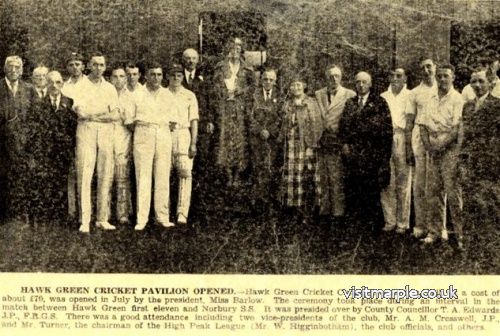
The club's new pavilion, built at a cost of £70, was opened by the president, Miss Barlow.
‘The Chippie’
Until recently the same family had run this, since before the War. It was closed for a period during the War, due to a shortage of cooking fat, but was re-opened after the War by a stepson of the family, Gilbert Schofield, father of Mary Darlington of Hazel View.
Gilbert had lost a leg because he contracted frostbite while delivering coal for Sam Bowden, but he managed to do the cooking while his wife served the customers. If we children had any spare pocket money, we would go to Mary's for a penneth of ‘scallops’ - flat chips from small potatoes, and a bottle of ‘Tizer, the Appetizer’- Bliss - we thought it a real treat.
The Newsagent (on the corner of Shepley Lane.)
In the 30s and 40s the proprietors were Mr. and Mrs. Green for whom I delivered daily newspapers, 52 in the morning and 24 in the evening. The 24 took twice as long because they were much further apart. I was paid 12/3d (61p) and compared with some newsboys in Marple I believed I was well paid.
They also sold sweets, which we called toffees because we thought sweets sounded sissy. Mr. Green always served dressed in a suit or shirt with a starched collar and a waistcoat, and he would carefully weigh out the sweets by hand, breaking up the lumps with a toffee hammer.
I don't remember the owners before the Greens, but my father (Frank Proctor) tells of buying lemonade and peas in the little back room. The ‘pop’ was sold in re-usable bottles with a marble in the neck. This was pressed in to allow the gas to escape and then to drink. The gas eventually forced the marble back into the neck with a sound, which is probably where the term pop comes from. I saw one of these bottles that had the name of the proprietor and ‘Shepley Lane’ embossed in the glass, so they were bespoke made.
Hardware Shop.
We called this The Ironmongers and it was run for many years by Laurie Frost, an ex-mill worker, and his wife. It was situated by the ‘gennel’ leading to Bramham Road. As you opened the door the bell would ring and Laurie would appear from between the goods hanging from the ceiling. It was a scene from yesteryear with paraffin, chicken wire, shoe soap, firelighters, pots and pans etc. He also mended shoes and dispensed the local gossip laden with gloom! He was quite a character, complete with withered arm, which he waved about! Mrs. Frost was a lovely and very friendly little old lady. Sadly, neither the Frosts nor the Greens had any children.
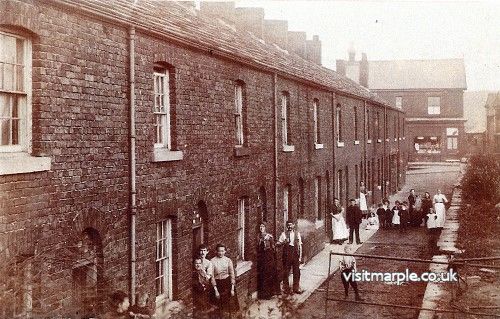
Rhode Houses in Hawk Green, built in 1855 to house workers at Rhodes Mill.
Confectioners
There were two of these.
One occupied the corner of Rhode Houses and Upper Hibbert Lane and was run by two sisters (in-law?) called Wilson and Pass. They lived in the bungalow opposite the Ridge Chapel and they were gentle souls who worked very hard baking and making lots of sandwiches for the mill workers. Mrs. Pass had an only child, Mary, who is now Mary Gill and still lives in the district.
The other confectioner's was situated by Eccles Bridge and is still trading. In the post-war years it was run by the Carringtons, with Kenny, who we believed to be ‘slightly handicapped’. He made the pies in the cellar bake house, and we kids often speculated whether the drips on his nose made their way into the pies! However, the pies, and the rest of the fare, tasted very good. The shop was kept very busy by the hungry mill workers, and Eddie, the Proprietor, also ran a delivery service.
The Co-op (on the corner of Barnsfold Road)
It was a substantial building with large dry cellars and a large shop area where they sold everything loose from ham to coffee. The ham was cut for you as you waited - "Thick or thin, Madam?" There was always a smell of coffee and cheese in the air and a pleasant, quiet atmosphere.
In the late forties and fifties the manager was Mr. Hubert Fletcher who was brought up in Hawk Green. His demeanor was dignified and quietly humorous and he was thought to be capable of a much more responsible job.
With such an investment the Co-operative Society must have expected quite a profit and this is surprising considering the small number of residents at the time the shop was built.
I can still recall our 'divi' number, which was 681, and the ‘divi’ system of repayment according to how much was spent in the shop.
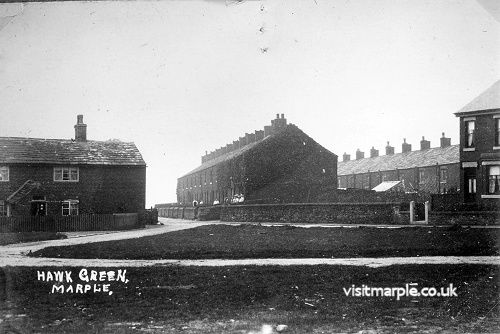
Hawk Green looking towards Barnsfold Road
The Greengrocers and The Butchers (on the corners of the Cricket Club access from Upper Hibbert Lane)
The Greengrocers was where the Newsagents is now and was run in the 30s by the Sharples family, and then in the late 40s by the Jones family. Trevor Jones, one of the sons, still lives locally and is a prominent member of the Carver Theatre. The shop lost out to the advent of the big supermarkets and people's increased mobility. The Sharples Family also ran a Butcher's on the opposite side of the entry. Later it was taken over by Dennis Allsop and his wife. He was a taciturn, rather doleful man, whose conversation seemed to me to be a litany of reasons why there was a shortage of various meats, though there was always an abundance of mutton. I can still taste it, and it begs the question of, why no lamb? To be mutton, surely it has first to be lamb?
Could it be that he, like Cpl Jones in Dad's Army had his favoured customers? Mrs. Allsop delivered the meat in her little shiny car. Dennis made his own sausages while the customers looked on. He also did his own slaughtering, shepherding the beasts across the road from a field which is now the car park of The Crown to pens in the passage to the Cricket Club where they waited for entry to the slaughter house. Mr. Allsop was a trustee of the Reading Room and would come in from his shop next door attired in open rain Mac and homburg hat, presumably to oversee his charge, because to my knowledge he did not use any of its facilities. When the Cricket Club was due to move to its present location in the late 1950s, Dennis had to be involved in the access negotiations, and he was not happy about the arrangements, though he had ceased to do his own slaughtering by this time.
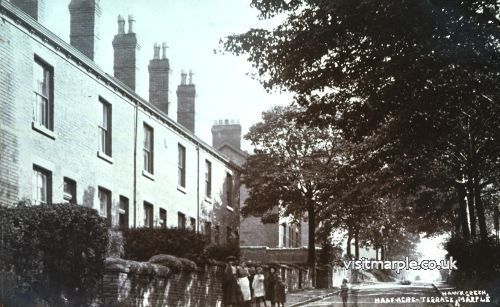
Half Acre Terrace, Upper Hibbert Lane - Looking up towards the Green.
The Off Licence (corner of Upper Hibbert Lane and East Drive)
This is a large premises with outbuildings that used to be the workshops of Mr. Eastwood, a local builder, who may have given his name to East Drive. His daughter, Edith Wood, was known as Edie and lived at the end house on the left. She was an attractive lady who was much admired by the local yeomen and she died in 1992 when she was about 80. Her husband, Jack had a wry sense of humour: if someone had been hurt, for instance at cricket, he would say, “Ne’er mind, it won’t ‘urt when’t pain’s gone”.
The proprietor of the off licence during the 1950s was Jack Rogers who was not known for his generosity. One Christmas, I bought four pints of Mackeson Milk Stout as my mother drank a bottle each night to relieve her chronic arthritis. As I made to leave, Jack called me back and presented me with a half-bottle: "Give that to your Mother and wish her a happy Christmas". Half a pint after 365! Good ole Jack!
The Crown
Much has been recorded about the ‘pub’, and the most accessible record is Jack Turnbull's 'Last Orders Please'. It was used as an occasional Magistrates Court, and I can recall stories of one landlord named Jabez Shaw who ruled the inn with great discipline, keeping good order and requiring no swearing and no games on Sundays, a rule which stood until well into the 1950s. I used to join in with the hymns, which were sung once the 'hops' began to take effect. This ‘pious’ behaviour was thought very worthy by some, and the resultant harmonies -Take oil in your vessel and let your lamp burn bright', and 'Glory to your Father, your father'.... etc. sounded quite wonderful; to their inebriated senses, until a certain Jack McKay brought in a new-fangled tape recorder. That caused a rethink, at least among those with an ear for music. It sounded absolutely awful, The Tap Room or Vault could be a very inviting place on a cold winter's night, with its heaped up coal fire, wooden benches and tables where cards and dominoes were played. There was waiter service, and here the local men exchanged gossip and ribaldries away from the women folk. With no TV, and no radio, even, for many and with wartime restrictions there was little else to do.
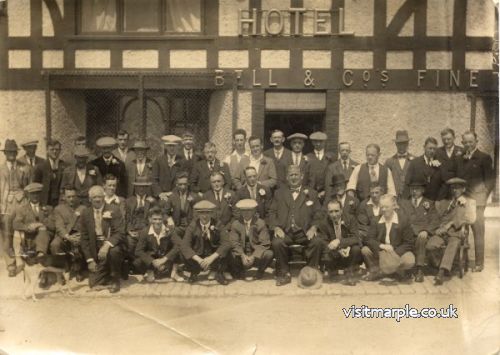
The large man at the centre is thought to be Crown landlord Jabez Shaw
The First Cricket Club
Around the turn of the Century, cricket was played adjacent to Number 3 Tee on Marple Golf Course, a few yards from the local Council tip. The track to this tip is the public footpath leading from the canal bridge at the rear of the Shepley Lane Trading estate. Little is known about this cricket pitch, but a move was made to The Green during the 1926 General Strike. Mr. Roland Eastwood, the local builder, oversaw the work using spoil and flue dirt from the Goyt Mill to level the ground, and local volunteer labour. The pavilion was on the grass verge at the corner of Windlehurst Road and Barnsfold Road. It was a black and white striped building with an upper storey for the scorers. There was, of course, little likelihood of being knocked down by a speeding car in those days.
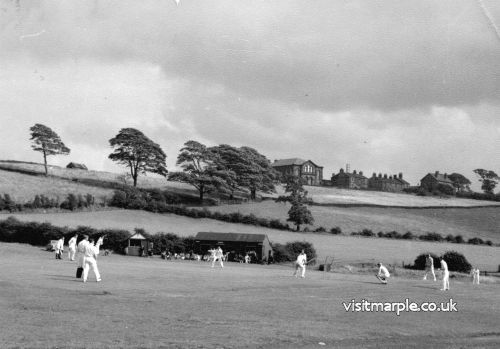
Cricket on the Green at Hawk Green
The next pavilion, a green striped shed, was on The Green proper, and cricket moved to the present site in 1960. The ground, original buildings and sightscreens were commissioned by a small band of dedicated players. Materials, new and second hand were begged and purloined locally for the project, and the land was purchased from the Goyt Mill for £500. It might have helped that Mr. Cyril Pott, one of the Directors of Goyt Mill, had been a keen cricketer.
We were very proud of the (un)-finished result of our labours when our President, Miss Barlow of Woodville, tossed the coin before the opening match in June 1960. Miss Barlow's brother was killed during the 1914-18 War. In the Reading Room hung a large picture of this moustachioed army officer, given in his memory. Lt. Barlow was a navigator/Gunner in WW1 and died when shot down by Baron von Richtofen, "The Red Baron". His story is recorded in the excellent book "Remembered" where all "the fallen" from Marple district are described in detail. The book, written by Peter Clarke, Andrew Cook and John Bintliff, is a worthy endeavour indeed and is possibly unique.
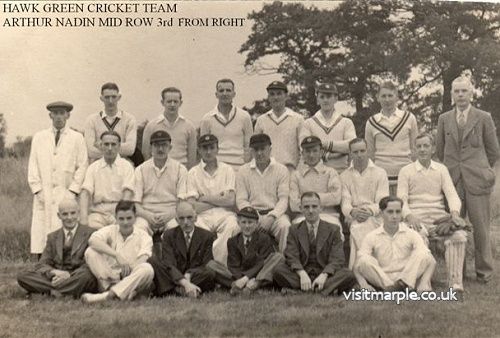
Hawk Green Cricket Team between 1930 - 1940
Many personalities are connected with the resurgence of Hawk Green Cricket Club in the 1960s and its steady progress since. One prominent player was Roy Ridings who played every year from the age of 14 until ill health forced him to step down at the age of 46. His main function was as opening bowler, though he once scored 65 runs in 30 minutes when batting. He played regularly in the Derbyshire and Cheshire League and in the late 70s was the premier bowler in the First Division where he never conceded an average of more than 10 runs and regularly took more wickets than bowlers given many more overs. All this was achieved by ‘training on beer and cigarettes’. Then there was Mr. Brelsford who always claimed that “Air ‘Orrice’ were t’ fastest boughler (bowler) as ‘Awk Green ever ‘ad.” Well, he was due for a trial at Lancashire County Cricket Club when war broke out, so “you never know.” (Sadly, Roy Ridings died in December 2007. About 200 mourners attended the funeral service).
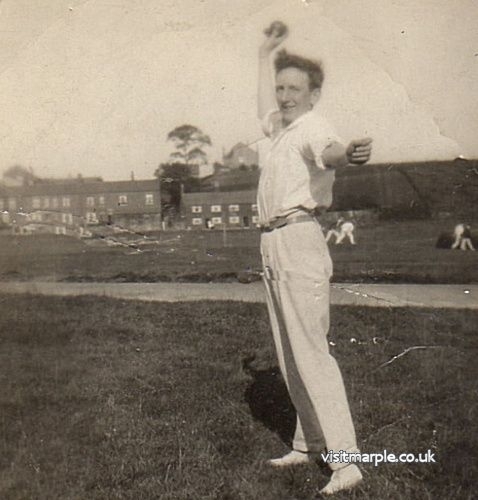
Arthur Nadin was a bowler for Hawk Green cricket club before and after WWII, 1939 to 1944.
One remarkable fact about Hawk Green Cricket Club is that for almost 40 years up to 1960 the game was played on an actual village green, that is to say a common land.
The local farmer with his 2 or 3 cows had the right to graze the animals on that pasture. This happened regularly and sometimes caused animosity. We thought it quite 'commonplace' and at least the beasts kept the grass low, though we had to remove their 'leftovers' before play could start each Saturday. According to one acknowledged source, this was the only place in the North of England where cricket was played on an actual village green. This must surely rank as an outstanding regional, if not national, attribute for our little community, taking into account all the many other features and oddities mentioned earlier.
Hawk Green Cricket Club - The Early Days
The origins of this proud progressive club are somewhat vague. However, it is established that cricket was first played in this area on the present Marple golf course, on the fairway of the No.3 hole, adjacent to what was then a local tip and where, until about 1985, people would dig to find artefacts - 'pop' bottles etc.
A hard standing road can be discerned under the grass leading down to the site, from the Shepley Lane canal bridge. The only real evidence we have of the existence of cricket there is a faded photo of just the gable end of the 'club house', certainly just a shed in those days, and that is all, no records (as yet) no equipment, and of course, no verbal memories. However, Wallace Jackson, a former very active member, did pass on a few memories before he died early in 2007, though, of course, he never actually played at the original ground.
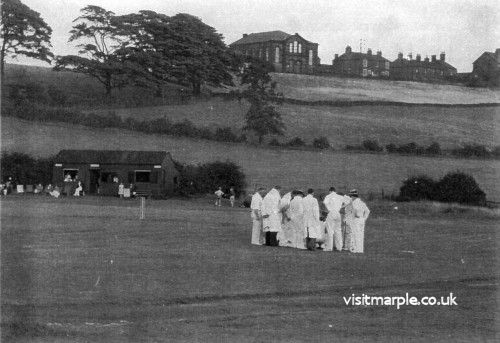
Cricket on the Green at Hawk Green.
We are also indebted to Wallace for relating the events surrounding the establishment of the organised cricket on the “village green”, which until the early 20s, was uncared for - a tip by some accounts. Being "common land" by statute meant that cattle and sheep could be grazed there. Apparently, supervised by a local builder, Roland Eastwood (he built East Drive) the green was roughly levelled using cinders from the Goyt Mill, which are still in evidence today. The playing square, however, was raised at the lower end and always played well. Indeed, it was lifted by the members and laid on the 'new' ground in 1958-59 -no cinders there, thank goodness!
The original pavilion was a black and white striped building situated across Windlehurst road where it joins Barnsfold road, so the players had to cross the main road to reach the playing area, just imagine that in today's traffic!
Incidentally, the scorers sat in a box built on the roof, perhaps the better to view the game. This, another unique feature about our club, added to the fact that they actually played organised cricket on a real village green.
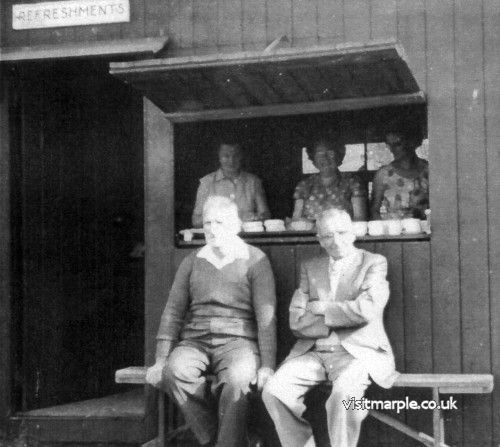
L-R: Annie Nuttall, Freda Waterhouse, Rose Nuttall,
Jack Kerfoot and Len Loach at Hawk Green Cricket Pavilion in 1950.
The 'new' pavilion was officially opened in what appears to be the late thirties judging by the age of the known players on a photograph, with dignitaries and with the chairman of the league, Mr. W. Higginbotham also present - which begs the question, would this be any relation to Bill Higginbotham of Hayfield C.C? Another unique oddity was the fact that, because of the cinder path right of way across the outfield, play would occasionally be halted when people would wend their way across on their way to 'the Ridge', quite unaware that the cricket was halted because of their 'trespass', accompanied by the sarcastic 'bellows' from the 'crowd'. Another feature of cricket on the green was the preparation required before each game.
In no particular order:
- heavy mesh guards protecting the engraved crown hotel windows (3) and similar guards at the large Co-Op window (3) had to be hung in place,
- the cumbersome posts & wire fencing from around the square had to be dragged away to four sides,
- for "health and safety" (in 1935), the pestholes had to be made 'safe' with square rebated wooden blocks,
- not forgetting the removal of the cow pats! (Usually just from two cows),
- place metal 'ring' post and rope to form two boundaries (the roads were the other two!)
Next, two even more important chores:
- Is the Elsan waterless toilet ready for use behind the 'pavilion' (Ugh!)?
- Is there enough gas to heat the tea urn for the ladies to use when they prepared our teas in the tiny 'kitchen' situated between the changing rooms? (the teas being passed through the hatch (no tables!))
The scorers in those days sat in the home dressing room,( too bad if there was a lady scorer!)
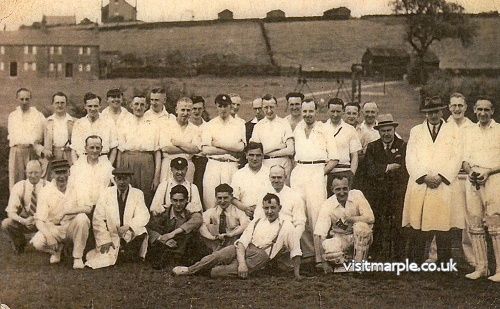
1940s Hawk Green Cricket Team.
Until 1957 there was no sightscreen either, then only at one end. The previous year saw the first practise nets on concrete, the provision of a 'summer' house for the scorers, (a gift), ground equipment (which consisted of spades, rakes, a white boundary marker, a very good 12 blade cylinder mower (we didn't mow the outfield, (the cows kept the grass low apart from where they'd been busy!)) - and not much else! Yes it really was village green cricket.
Outstanding memories from the 30s and 40s; I was delivering papers near the Goyt mill when a group of players came down the middle of the road (no traffic); it was the Romiley team who had been dismissed for 9 runs! They walked to Marple train station - no cars in wartime! Another memory was the so-called "Whit Walks", with the large banners carried by sturdy men, and supported by 4 guide ropes. The procession would stop on the green, where a short service with hymns took place, halting the cricket for half an hour. Imagine that nowadays!
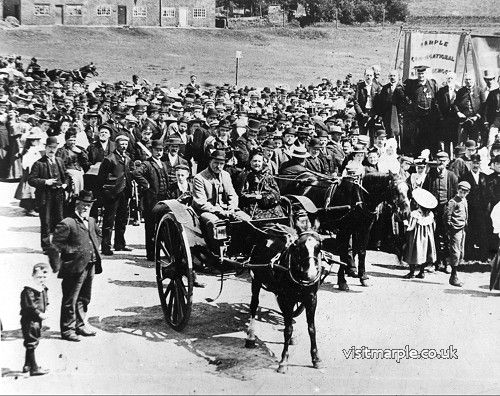
A large gathering at Hawk Green (a bit before Alan's time)
Hawk Green (only one XI) won the High Peak League title in 1945. The deciding game took place on The Green - what a day that was! Another highlight was a cup match about 1957 when Hawk Green were drawn at home to a first division Chapel-en-le-Frith over two nights, (no promotion/relegation, never the twain!) Well there was never such excitement; They were like gods to us! - And we won. Next round we crashed out to another 'top' side, New Mills. But we had had our day in the sun!
The Goyt Mill
It was completed about 1905 and replaced Shepley Mill next door. The mill gave much-needed employment to the local populace, although no one ever got rich quick by working there. It served this purpose until the decline of the cotton industry in the early 1950s. Since then it has been used as industrial manufacturing and leisure units, so still provides some employment.
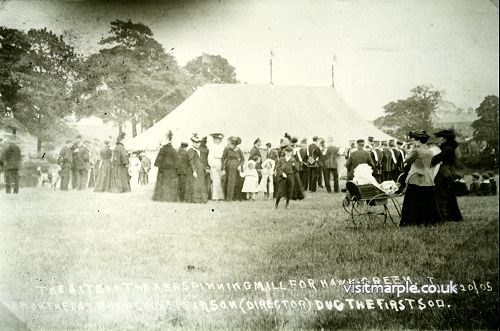
Celebrations at the site of the new spinning mill for Hawk Green on 20 July 1905
When Shepley Mill was demolished, in the 1930s, a firm from New Mills carried stone along Shepley Lane in a truck bearing the name of S. B. Marshall. When we kids were playing hop scotch or whip and top in the road and we saw this, we used to shout, “Eh up, ‘ere comes Sugar Butter Marshall. I know little of life in the mill, but I delivered an evening paper to the stokers and steam crane man, and a morning paper to the engine room. Here, the massive Belgian-made engine, with its two reciprocating pistons, drove the shaft drives on every floor via the rope race, which had fifty-two grooves (I counted them) around its huge drum for the ropes. It was an awesome sight for a small boy. (If only Fred Dibnah could have saved this magnificent machine with its elegant surrounding wall tiles. It would have been a national treasure).
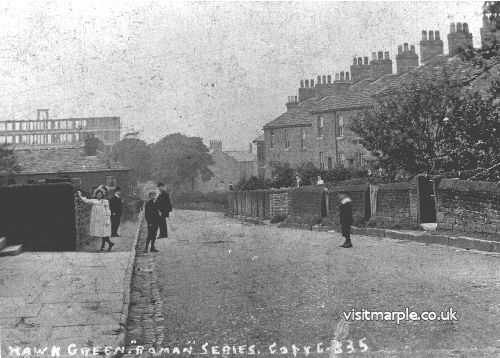
The Goyt Mill under construction in 1905
The steam crane was mounted on a short track leading from the arched bays, which can still be seen by the canal. We would watch the driver drop the grab into the coal barge and hoist away with a steamy clatter into either the boiler hopper or the storage area for later use. One Sunday afternoon there was a fight between a father and son who tumbled about among the coal while mother screamed at them from the tiny cabin of the narrow boat where they lived.
A sad event was the suicide of a man who lived in Rhode Houses and worked in the mill. To hide the evidence, cinders were spread around, but we ghoulish kids examined this carefully and told the gruesome story at school.
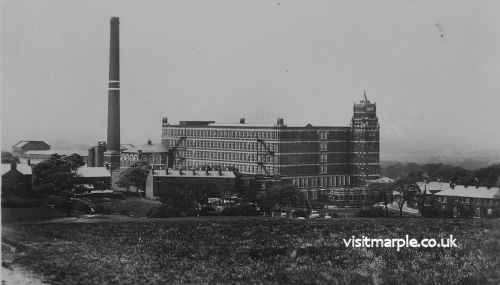
The Goyt Mill at Hawk Green
Shepley Mill was a spinning and weaving mill, as was Hollins Mill. Goyt Mill was purely a spinning mill. The ground between Goyt Mill and Sunwell Terrace was left uneven with spoil from the building, and unfenced, and made a great playground. We would hide and scramble and build dens with large drums around holes in the ground. From there we would raid other dens around the area, which caused reprisals to our headquarters at the Goyt Hills! We also made forays to the quarry on The Ridge, and we had a perfect adventure playground.
More about the Goyt Mill
This elegant late Victorian structure built in the grand style of the period: arched windows, turreted walls, buff coloured terracotta and distinctive wall tiling, would be prohibitive to build nowadays. But that is how things were done in the days of cheap -materials and cheaper labour, however, much of the exterior fabric of the building survives to give the onlooker an impression of how it would have looked on its completion in 1905. The advent would, of course, been welcome in the district providing work for the semi-skilled and unskilled workers in the area, replacing the demolished (burnt down) Shepley Mill next to it. This site was still being cleared in the 1930's and is now a newly built industrial site, once again providing services and employment, as of course does the Goyt Mill rented out in units.
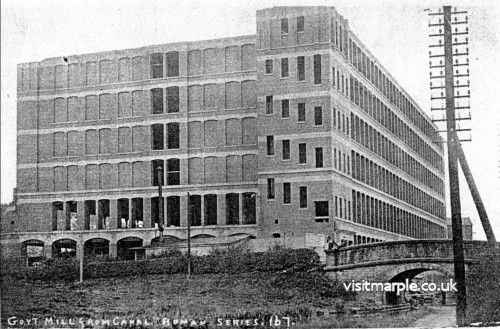
The Goyt Mill during construction.
My recollections as a child in the 30's and 40's were of the general noise and activity around the place with many employees, some arriving and leaving on the North Western bus specials, one at least being an old petrol engined Tilling Stevens brought out of retirement (for the transport buffs!).
All this took place during the week, the weekend being reserved for maintenance to the myriad engineering and other needs, one important aspect being the massive Belgian made (I think!) steam turbine (me being a paper boy being allowed to visit when I wished). This drove an enormous drum with 52 grooves in turn driving the line shafts to each floor level via ropes almost disappearing up a cavernous open shaft (present day Rope Race) with cotton waste and general dirt covering the walls and shaft bearings in complete contrast to the tiled, ordered cleanliness of the engine room.
The whole would be a tremendous tourist attraction nowadays, 50 years or so after the closure of the mill caused by the inevitable cheaper imports, especially weaving although the Goyt Mill was a spinning mill only whereas the adjacent Shepley Mill (a family mill-owning name) had been a spinning and weaving unit too.
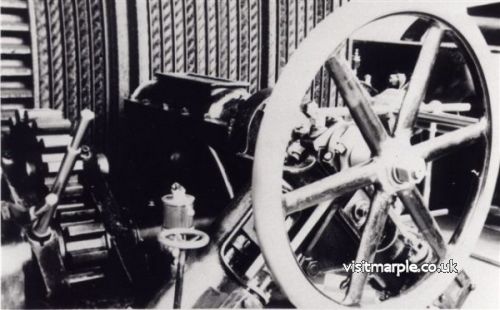
A barring engine in the Goyt Mill.
The surrounds to the area provided an interesting varied playground in those less security conscious times with the so-called Goyt hills (excavation dumped untidily next to the building). We used to play various games, build our dens with cotton drums etc. We would hide or plan our raids on a nearby gang's own den - all innocent fun with no vandalising.
The coal to heat the boilers was delivered by narrow boats to the wharf close to the second bridge with the arches, where the coal could be off loaded when the steam crane was not working. This would run up and down on a short track to the bunkers behind the boilers where the present Goyt Glass and Timber unit is situated (2003). When the bunkers were full, the coal was dumped in a great heap nearby for later use. One Sunday afternoon a father and son were fighting on this black pile - they lived on the narrow boat delivering coal and mother was screaming at them from the tiny cabin. This is how even large families lived, the boats providing accommodation and a meagre wage (no doubt) in return for their labour. It seems the two men had been to The Crown at lunchtime, but I am sure the claustrophobic living conditions played a large part.
Water Supply
Before the advent of piped water to every household and commercial or farming unit, this most necessary commodity was gathered from wherever it ran, or was found in natural underground springs and watercourses. Of course, the resourceful villagers of Hawk Green made sure that there was a supply for families and farms, not to mention the thirsty carthorses that passed through every street. The local wells were meeting places as well as oft-used collecting points. Only one can still be seen, and that is opposite All Saints’ Church. If the local Council, or other caring people had had the foresight to refurbish and name the others they would make an interesting piece of history. At least another three were still running in the 30s, one by the junction of the footpath and The Ridge, below the Ridge Church; one on what we always knew as Love Lane where the old Shepley Mill wall terminated and opens out on to a field, and yet another on Shepley Lane almost opposite Love Lane. I fell down this one at the age of 7 and still have the scar caused by the barbed wire. These last two were probably kept running by the water course which supplied the Shepley Mill lodge (reservoir), just below the present cricket ground. It passed from the chapel, under the Crown and across the cricket field and then almost certainly under the canal to form the stream which emerges halfway down the golf course and flows under the road at the bottom of Dan Bank to join the River Goyt near there.
Hawk Green’s War
The War affected everybody in one way or another, but the most frightening, and the most exciting time for children was the two years or so after the initial invasion scare, following the retreat from France, when the Country suffered bombing raids to many towns, airfields and factories, and the Manchester blitz came around Christmas 1940.
It was exciting coming home from choir practice during an air raid to shelter with my Mum under the stairs. Prior to these air raids, many child evacuees were housed with local families, and a boy called Fred Bradley lived with us at 11 Shepley Lane. These children were soon homesick and went home once the bombing scare was over. There was a shortage of everything and everyone had a ration book from birth to death when it had to be surrendered - to stop fiddling! Sometimes they were used for bartering.
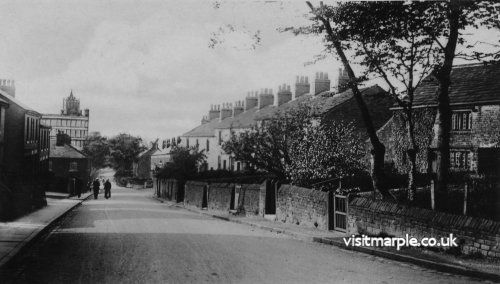
Upper Hibbert Lane, Hawk Green
In 1939 the LDV (Local Defense Volunteers) was formed and they would parade at the back of Rhode House using a large shed as a base. There was an Austin Gipsy-type trailer parked on Shepley Lane as a mobile HQ and it was almost laughable, though it did a great deal for morale. LDV was often corrupted to “Look, Duck and Vanish”. All this helped us to forget the impending conflict and hardship.
Before the air raids in 1940 each street was issued with a stirrup pump, which was kept by the ‘Section Leader’. In Shepley Lane was my Father, Frank, who showed others how to fight a blazing house; a forlorn hope, on reflection, though it fascinated me as a 9 year old.
At least three unexploded anti-aircraft shells landed in the area. One came to ground at Rathbone’s Farm near the Romper (at Ridge Fold) causing the death of a horse, while another caused great excitement when it exploded on the Goyt Mill parapet.
Another great event for us children was the shooting down of a German bomber during the Manchester air raids, when we, amongst many adults, crowded round the site near Wilkson’s Farm on Torkington Lane to forage for souvenirs, mine being a piece of fuselage with a lingering smell which continued for years. The prize find was the propeller blade, dug out by Peter Hamman (whose brother was shot down over Germany and killed) and Eric Booth. Sadly, it was given to a Rag and Bone Man. Another piece greatly envied was a strip of tail with a swastika on it. Wow! What a prize! The local doughty Home Guard turned out in a failed attempt to capture the four-man crew who parachuted to safety around the Stockport / Bramhall area. Shades of Captain Mainwaring of TVs Dad's Army and his brave men!
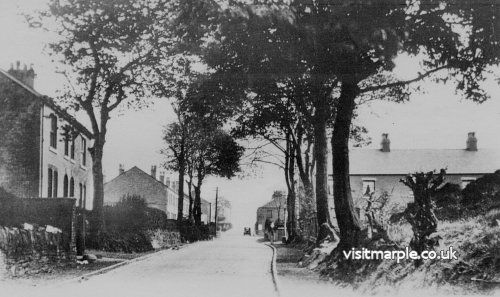
Upper Hibbert Lane, looking uphill from the Goyt Mill.
The children’s war effort, didn’t amount to much, as far as we were aware, but we were asked to ‘volunteer’ to help the local farmers in the fields. To this end we were given a card with 20 spaces for the farmer to fill in when we attended. He might or might not give us 2 Shillings (l0p), and some boys would ask the man not to sign their card, thereby giving them a further afternoon off school!
An air raid shelter was dug at the bottom right hand comer of the Green. I doubt it was ever used, but it made a great playground, especially once the locks were broken. An attraction for the young boys in the area was the chance to join the Air Training Corps, the Army Cadets and the Sea Scouts. This was encouraged, because it was considered patriotic, though to the kids the fascination was probably the uniform, the fun and the camps.
The birth of a black girl to a local maiden caused a stir at this time, mainly because the locals had never seen a coloured person, so it got the tongues wagging. However, she was well brought up as a Methodist and became a very pleasant young woman.
A facet of children's lives in the 30s and 40s was the amount of time spent playing outdoors. The boys built dens, ‘explored’ and ‘climbed’ in one of the two quarries, played scratch games of cricket and football on the Green, hopscotch, bowl and hoop, whip and top (all of which had a season), and were simply together in the street.
Despite rationing we must have been fitter than children in the 90s, with their preoccupation for the computer and the television. For instance, Jack Oliver, Roy Griffiths and myself, Alan Proctor, aged fourteen, cycled to Chester and back in one day (about 94 miles) using ‘sit up and beg’ bikes without gears. Can one imagine that nowadays.
More about Wartime
It was fascinating for us children to see the young men in uniform: roughly tailored, heavy serge outfits, but symbolising the heroic battle against the enemy, epitomised by the comic figure, as portrayed by the cartoonists, of 'Adolf’ (Hitler) whose doubtful parentage (Mother Shickelgruber!) and ranting speeches made him a figure of ridicule. This was no doubt encouraged by the Government to boost our morale. The Fuhrer's caricature appeared everywhere with its silly square moustache and hair swept down over one eye. It was a special favourite of the RAF ground crews and it was a regular feature chalked on bombs on their way to occupied countries. The uniforms worn by our lads were much inferior to the ones worn by the American G.I.s when they arrived in this country. Even their lowly private was better and smarter dressed than our higher-ranking NCOs and Officers! As comedian Tommy Trinder was wont to say, "They're over-paid, over-sexed and over 'ere!" The initials G.I. are generally accepted to stand for 'General Issue', hence G.I. Joe. In those days the ordinary soldiers, 'our lads', were always referred to as 'Tommy Atkins', or 'Tommies', later as 'Squaddies', anything but soldiers - too square, as they would say now. Even then there were slang terms or colloquialisms, just as there are today.
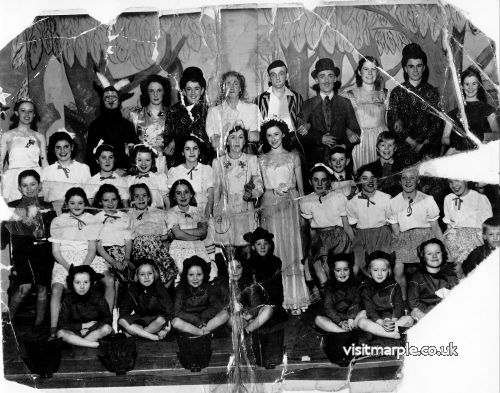
Hawk Green Ridge Methodist Panto c1952-53
Back row L-R: Pete Barber, June Wilson?, Bernard Brooks, ?, Harold "Curly" Robinson, Bert Russell, Carol Beard, Gordon ?. Far left: (Fairy with wand) Wendy Sloane, Far right: Ann Horrox. 2nd row down: 6 unknowns, Tony Ross, Roy Ridings, Derek Ridings. 3rd row down: John Moores, Jean Ridings, Brenda Cooks, Jill Chatwood, Sheila Worral, ? Cox, ?, Jean Leadbetter, Valerie Moores. Bottom row: Glynnis Brookes, Irene Chatwood, Barbara Cooke, Susan Dale, ? Potts (dog), Margaret Crammer, Judy Hornby, Beryl Sweeney, Keith Chatwood.
One facet of wartime around here was the continuous presence of the famous four-engined Lancaster bomber, the finest war machine, which was produced in the area. The airplane was to be seen almost daily being test-flown from Woodford Aerodrome where it was assembled and tested. The various components were made within a 100-mile radius and the plane assembled and then put through its paces over Cheshire. The four Merlin engines droning through the sky made a never-to-be-forgotten impression - I can still hear them!
War Time Recollections
My first Wartime Memory lingers very strongly in my mind and it took place on the very day that war was declared! I was a choirboy at All Saints Church (complete with its separate Bell Tower-is this unique?). On Sunday 3rd September, 1939 we, the choirboys, were playing 'Battleships' on scraps of paper, having dutifully sung earlier hymns along with the male tenors and bass behind us while the Vicar F.S. Spackman was preaching his weekly sermon - no doubt including the impending conflict - though we were not listening - when suddenly at 11.05 the Vicar's daughter Helen came hurriedly down the aisle, her father meeting her at the alter steps where a murmured conversation took place. Helen then hurried back down the nave. Mr. Spackman; who had served in the First World War, strode back to the pulpit, abandoned his sermon to lead us all in solemn prayer for all souls who would serve and suffer. We all then sang the closing hymn. We choristers processing to the vestry. Of course to young lads, I was aged nine, it all seemed very exciting. Chattering while we took off our cassocks and surplices. Then outside we watched with curiosity the congregation worriedly discussing the events of the moment and in particular one Janet Fielding, weeping on the shoulder of her fiancée Sam Graham, knowing that he would be 'called up'.
Well, Sam was 'drafted', served in the Army, became a prisoner of war and came back to live in Hawk Green with wife Janet. Working for the Co-op he later became a self employed Grocer before becoming a Teacher. He also, for many years, opened the bowling for Hawk Green Cricket Club on both the Village Green and later the new ground across the road.
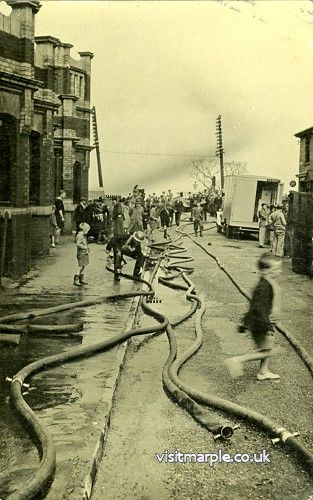
An ARP Exercise near the Goyt Mill in 1938-39.
I also recall seeing the Barrage Balloons (to bring down low flying aircraft) tethered above Manchester as we all looked that way from our unhindered view in that direction - no buildings then of course, just fields all the way from Hawk Green to Marple. So the government must have been planning for the expected War even then, or is my memory playing tricks with the timing? However they were certainly in abundance in the area with one unit stationed at the bottom of Ley Hey Park (Road) along with an Anti Aircraft Gun. In later years the buildings alone were still there with we young boys assembling there in the 'Army Cadet Force' pretending to be soldiers; Drill, Manoeuvres and the occasional trip out with the Annual Camp at Kimnel Bay and Pensam, North Wales, being the main attraction and of course the Uniform! Imagine the same situation in 2005 - most boys would simply scoff at the idea.
There was, of course, a fear of Raids by German Bombers so the preparations for such events included the Building of Air Raid Shelters, of which there were two on Hawk Green – neither would have provided any real protection. Issuing Gas Masks to everyone, including babies, Sandbagging important Buildings, Painting the edges of wings of vehicles (some with a Gas Bag fixed above) taking down all the road signs with all lights extinguished after nightfall. A familiar cry 'put that light out' would become a catchphrase with heavy curtains or blinds a permanent fixture.
Firewatch Teams were formed and stirrup pumps issued. Later of course Food Ration Books were given out and frugal though they were the diet is now said by some to be healthier than in 2005. However I know which I would prefer -not cold mutton, rissoles, Snoek (fish) Sago Pudding which looked like frogspawn, Corned Beef and other unappetising offerings, which was the normal fare for years. Rationing only faded out about 1950 even though hostilities ended in August 1945!
Also we have to remember that sweets (toffees to us) soft drinks etc were in short supply. Newspapers - mainly war news - used only 4 pages. Everyday items and goods such as oranges, bananas and others normally imported goods were not seen for five to six years! In fact anything deemed not important enough to take cargo space in the sea going convoys coming to our beleaguered island.
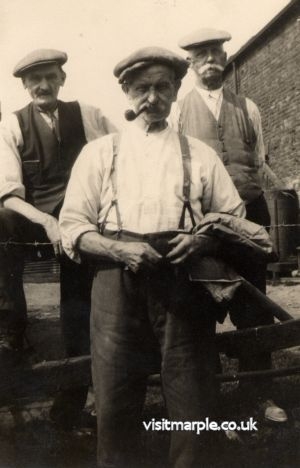
Men of Hawk Green: Jim Turner, Bill Pott and A.N.Other.
Petrol of course was strictly rationed with the tokens being in great demand on the black market and many were the charges brought by the courts for offences against the system, such as showing a light through a chink in the curtains during the black out - brings to mind the TV series Dad's Army and the cry of 'Put that light out' by Air Raid Precautions Warden Hodges!
The convoys mentioned earlier, bringing goods and desperately needed materials for our War Effort were decimated by the German U Boats (Submarines), until later in the War when our methods improved. Many of our slow moving merchant ships and naval craft were sunk. Thousands of lives were lost in the so-called Battle of the Atlantic. Eventually with more than 700 U-Boats destroyed we gradually came out on top but to quote Winston Churchill, our inspiring Prime Minister, "It was a mighty close run thing" so thank God for the brave merchantmen, coastal command and the Royal Navy!
Books by Nicholas Monsarrat, who served as an officer aboard a Navy Ship at the time, give an excellent account of dangers and exhilarations of Life at Sea and ashore of the period, though harrowing at times.
At School and Play during the war
Most Children, depending on their age, took all this in their stride since there was no alternative they knew of and took their pleasures simply by playing outdoors where possible, playing all the games mentioned previously. They also enjoyed exploring the area around Hawk Green, Marple and the so-called Roman Lakes. The area, which I now realize, as a mature adult, is a varied and interesting one, gives opportunities to young and old, if only young people could tear themselves away from their Video Games to discover them! During my time at All Saints School on Church Lane there was only one male member of staff -the Headmaster Mr. Refill - there was briefly a Mr. Stead who went off to the war and came through it. Now Mr. Revill - "Revill the Devil" as he was to us children- a fearsome man who lived in the house next to the Playground on his own and when he strode round the main hall where two classes were held the floor would shake and so would the children as he came by. The punishment for any slight misdemeanour was to be the command “Go to the desk” by the class teacher. The “Desk” in question was Mr. Revill's office which consisted of a line of freestanding 6'6" partitions against which the miscreant would stand with their back to the class in the open hall behind - just imagine the feelings of both the unfortunate child awaiting the usual punishment by the Strap, “Hold out your hand Boy" and the children sat at their desks pondering their possible fate. A kind of fear children have not felt for many many years. We did behave well generally but we had to learn how to dodge the flying chalk when not paying attention! Mr. Revill would even walk past the trembling boy - he was kinder to girls - more than once before calling him into his 'corral' leading to further torment before punishment. In fact the so-called 'strap' (leather with tails) was a relief. Further partitions as described earlier, also served to divide the Main Hall into two sections so obviously the general noise could be heard throughout the room and access to other classrooms was also gained by passage around the pupils at their desks, which in turn was a distraction for them and the teacher.
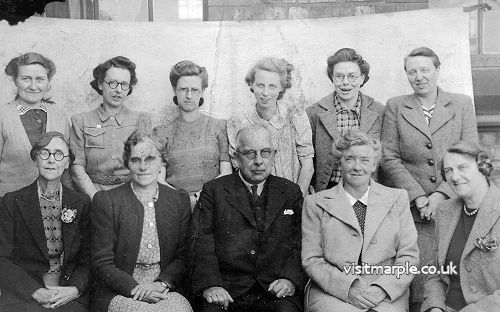
All Saints' School Teachers in 1945
Names: Front Row: Miss Walker, Miss Johnston, Mr Revill (Headmaster) Miss Dobson, Miss Hayes. Back Row: Miss Sheldon, Miss White, Miss Lockwood, Mrs Titterington, Miss Brown, Mrs Key.
The games and pastimes we children took part in during playtime were many and varied. In fact some would not be allowed in 2005 - they would involve physical activity and of course there was no supervision. Leap Frog, Tick, Whip and Top, when the so-called 'Window Breaker' could fly through the air. To make a slide as long as possible on frozen snow was great fun. All these games were good exercise and must have improved all round coordination, unlike playing computer games or watching TV.
One day the Air Raid siren was heard so we all hurried out of school to the Air Raid Shelter across the road to await the 'All Clear'. As we did so an Aircraft flew over in the clouds, further exciting us, although it almost certainly was one of ours.
In the early part of hostilities the cardboard box containing a Gas Mask had to be carried over the shoulder until it became clear that no gas attacks were expected.
A notable fact of that period according to Miss Brown (who still lives at the age of 90 in a nearby house) is that there was no national curriculum for learning since it was decided by the County Education Authority with local interpretations - surely an unsatisfactory situation but who knows? A further blight on our education was the system of taking children out of Senior School to help the farmers to 'Dig for Victory' - not that we didn’t enjoy the afternoons out even though we were not usually paid.
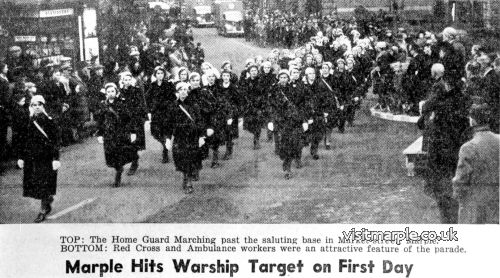
In 1941 Marple held a "Warship Week" and raised £60,000 on the first day.
As to Fashion - in clothes or mode of dress - well as with everything else, apparel of most kinds were on ration. The ladies would rekindle their dressmaking skills while the men would perhaps turn their gardens into Allotments to produce vegetables and even repair the family's shoes, which begs the question how many houses now will even own a cobbler’s last? The clothes in the 30’s and 40's would be almost Victorian, especially amongst older folk with ill fitting suits and so called sports jackets - often to be seen with flat cap and braces. However, not seen too much nowadays, polished shoes and boots! The ladies would wear frocks, unlikely coats and hats and Woolen & Lyle stockings - no nylons of course.
The Deprivations were many. Discipline and war efforts abounded but people bonded together for the common good. As witness, in a very minor way during a recent water cut off when help was offered to neighbours.
Humour too, was a morale booster when wartime songs and radio comedians, not to mention local plays and pantomimes would help to lift the populace. We kids would parade around doing the Goosestep (German ceremonial march) with one finger under our nose (moustache) the other arm raised in a Nazi salute shouting "Zeig Heil" - well, we thought it was funny. Remember Basil Fawlty.
Time and space hinder further recollections and other data. Other interesting anecdotal accounts and facts can be found in Local Historian Jack Turnbull’s Book 'A village at War".
Yes we The Allies did 'Win the War' but at great cost to life and indeed our way of living. Simple pleasures eventually gave way to more sophisticated ways but many people look back with some nostalgia on those war torn years and at least we were not under the Nazi Jackboot as much of Europe was where the War raged in its most savage way.
Local Characters 40s and 50s
To the great amusement, or consternation, depending on those within earshot, a certain Mr. Cartledge, who had lost his reason, would tell the same ribald joke, concerning the comparative bravery of the Home Guard and Soldiers - an old chestnut, to anyone he encountered. His favourite spot was at the bus stop where he had a captive audience. He certainly made us kids giggle.
I remember an old farmer from Windlehurst being asked in the Crown what on earth he was smoking in his pipe, and he replied, “Green end of a goose turd, dun’t it smell good?”
Bob Morton, who lived at the cottage by Brick Bridge, used to cause a stir when he drove up through the village sounding his horn which summoned anyone who needed a charged-up accumulator to meet him by the Co-op so they could exchange the flat battery for a charge of 6d (2½p). This meant that we could then tune in our radios to I.T.M.A. and Happidrome, not to mention Lord Haw Haw (William Joyce, the Traitor, in Germany). The reader may puzzle why we needed a battery, but many had no electricity, not to mention no central heating, and a shared outside lavatory, with a mangle and dolly tub to do the washing. Hard times, though we didn't realise it then.
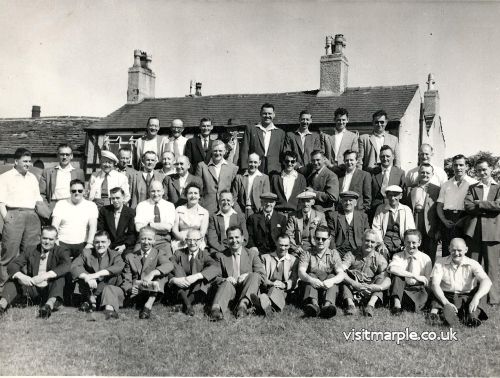
Crowd at the Crown Hawk Green
Front row: Hamer Ridings, Sid Atkinson, Fred Adshead, Jim Yarwood, Eddie Lang, Kenny Carrington, Mick Hill, Bert Geldart, Dennis Turner, John Close.
2nd row: Jimmy Shufflebottom, X, Bert & Nellie Wolstenholme, Charlie Eyres, X, Jim Stubbs, Mr Totterdell Snr, Ewert Humphries.
3rd row: X, Roy Hallas, X, X, X, X, Wallace Booth, George Nuttall Snr, Jim Price, Tony Riley, Jim Riley, Frank Cocks, Mr John Moors, X, in front Ernie Moss, X, Billy Carter.
Back row:Alf Higginbottom, X, X, Mr Burgess, George Nuttall, Ken Smith, X, Joe Totterdell.
X = Unknown.
Some of the local 'wrinklies' would sit on the two forms by the then bus stop, with their legs through the open back, leaning on the back rest puffing their pipes while making ‘helpful’ comments on the cricket match before them. Their acid comments were not always appreciated but were a real slice of village life, which I remember with great nostalgia. One of these forms was a classic with a wrought iron frame resembling tree branches. The Council, in its wisdom, took them away, along with a large boulder (from the Ice Age, so our Teachers told us) from near the sub-station corner of the Green where we would meet, slide off the boulder (it was very smooth), play tick, hide and seek etc. Why take it away? - Council – another bloomer!
One tragic event in the 40s was the murder of a man who lived at Rhode Houses with his wife and daughter. The daughter was in her early twenties and did not have a job but lived a life of comparative privilege and was able to keep her horse stabled at home. Her father came home every evening in his large car, despite petrol rationing.
One day she took a shotgun to her father because he had refused to buy her a second horse. The resultant scandal and police presence caused quite a furore and took people's minds off the war. The unfortunate woman was tried and detained at His Majesty's Pleasure, one aspect mentioned being the effects of schizophrenia. It was the first time many of us had heard either phrase. The whole affair was very sad.
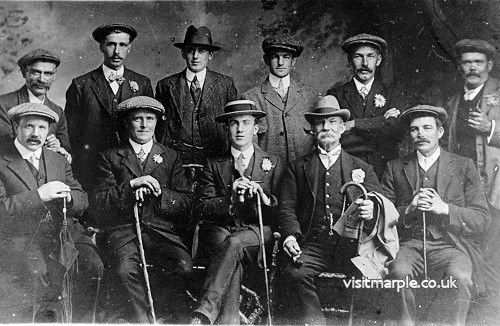
Builders from Hawk Green at a topping out ceremony - possibly Goyt Mill.
A remarkable fact about Hawk Green at that time, and later, was the number of 'only children' in such a small community. There were more than twenty, not counting those with half-siblings. One can only speculate on the reasons - something in the water, perhaps?
Herbert and George Nuttall
Since the original booklet I penned for the exhibition some years ago, one or two locals have pointed out a few omissions! Well, it was put together in rather a hurry, plus there was insufficient time. So to make amends here are a few addendums!
Herbert and George Nuttall were two brothers (big men) who both served in the forces during the war, as did many Hawk Green lads. Herbert, the eldest, fought in France with a guards regiment and had fond memories of his return to the villagers he met during his service there. He later became a policeman for a time, becoming a professional wrestler and briefly a boxer. He married a Marple girl, Dorothy Whatmough, who used to serve in the ‘chippie’ in Market Street, Marple. They lived on The Green with their four children.
George, the younger, named after his father, served in the Navy and we can only imagine how cramped it must have been when they returned from the war! The house was a small 2 up 2 down with an outside loo!
They all weighed around 16 stone though Mrs Nuttall, a doughty lady, was quite small. George who married a lovely lady called Jean Selby from Mellor (a love match - both very good looking!) also settled in The Green and they had five children.
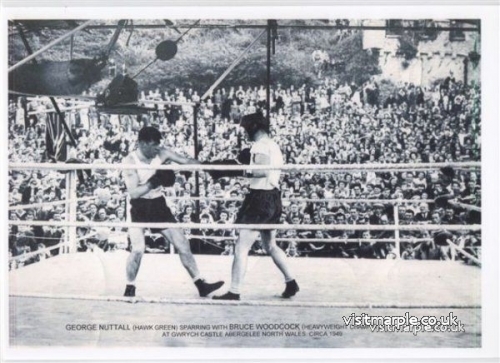
George Nuttall sparing with British Heavyweight Champion Bruce Woodcock in 1949.
However, George (Junior) became the more ‘famous’ one when he rose through the heavyweight boxing ranks to become an area champion. Locally he was a hero although he would have laughed at that phrase - he was too nice and good-looking (my wife, Joan, as a young teenager used to offer to shop for her mother at the shop where George helped out). Interest gathered apace when he became a sparring partner for Bruce Woodcock, the then British and Commonwealth Champion and coaches were hired to watch him fight at the Kings Hall, Belle Vue (the old zoo, amusement and leisure park in Manchester). However, when he retired, still young, his dad still had ambitions for him, as witnessed one night when my pal and I took him home after picking him up ‘in his cups’ outside a pub! We stopped the car at the entry leading to his home and he leaned over from the back seat and pronounced “Air gud is thardest ‘ittin’ ‘eavyweight int wurgled”. Just then his wife appeared at the car door. George staggered out, stumbled on the uneven ground with Mrs Nuttall helping him on his way with “get inside – you’re drunk. Where've you bin ‘til this time?” and she became the hardest hitting housewife in Hawk Green! Obviously that’s where her two big boys got it from!
Yes, the housewives in the past had to cope with many hardships. She was one of many I knew (on reflection) whose capabilities in those restricted, male-dominated times were admirable. My own mother, Annie Proctor, was another.
The brothers were both keen British Legion members and when they died within two weeks of each other, one Christmas in the early nineties (George walking one of his long time pets, a whippet), they had written in their wills for a roll of honour board to be placed in the Legion lounge. Their two names head a (now lengthening) list of deceased members. Thank you boys!
George and Herbert Nuttall were true Brits, a vanishing breed I fear!
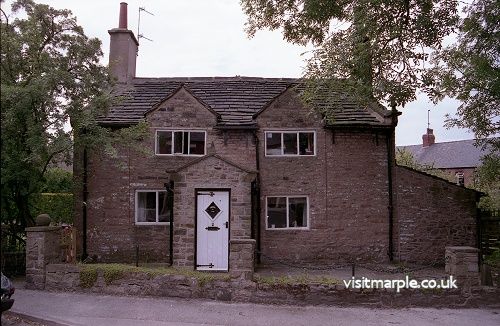
House on the corner of Shepley Lane (Marple Civic Society 1993)
Alice Barber
One old spinster lived at the 1666 stone house at the comer of Shepley Lane, Alice Barber by name, whose father would put tar on the walls of his half acre plot to deter us kids from sapping (stealing apples). When she sold up to Jack Oldfield, a local journeyman, she moved into No 13 Shepley Lane paying rent of about 10 shillings (50p) per week. Her electric bill was once 17 shillings (80p) for a quarter! Since my wife and I lived at No 11 we gleaned many stories from her, all said in an accent the like of which is never heard in these very different days to when she grew up. (We did have a tape of her telling a story although I am afraid it is lost - at one point she said “turn that theer gadget off - ir isna me!” meaning “it isn't me”.) She once told of her brother who lost a leg in the 1914-1918 war in France, who came home drunk from The Crown after regaling the locals with his experiences and was locked out by his father. He apparently fell asleep “inthorchard”!
Our Stan
Stanley Taylor could certainly be described as a character; one reason being he had what is nowadays called 'learning difficulties'. However, this handicap did not prevent him from leading a useful life for he was always to be found at the new (1960) Hawk Green cricket ground, even at times working solo. This when not looking after the pigs at Mrs. Jacobs' smallholding. For the latter toil he was paid 10 shillings (50p) a week, the positive aspect being not the money, but his mother 1.5 miles away always knew where he was, as with the cricket club.
For a number of years the club members toiled away (the usual few) digging drains, laying footings, moving soil and finally erecting the second hand pavilion we were given, adding the original building from the village green at each end. The whole project was quite an undertaking. However, Stanley was ever-present calling for the keys in the morning to start work right away. During the day he would be despatched to brew the tea, later to be "wound up" about its quality. The jibes about this and his general work would, to a stranger, seem insensitive and cruel, but not to those who understood him. Stanley acted as light relief at times to the beleaguered few, replying with unwittingly hilarious answers accompanied with the cackling laughter. He gave us lots of memories, which the older club members still talk about. An instance would be when visiting players attempted to take the rise out of him but found themselves the biter bit, wishing they hadn't tried!
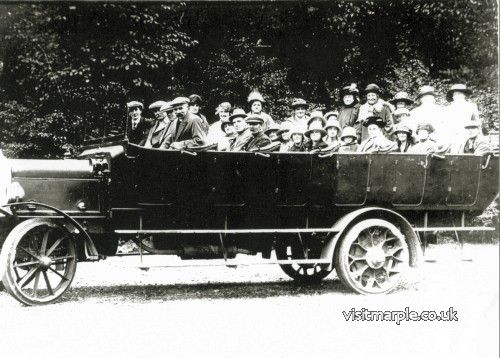
People from Hawk Green on a coach trip.
A fond memory of our hero is of him abandoning his wheelbarrow to dash off to meet the approaching band, whereupon he took his place ahead of Ray Noble (the Mace bearer leading the marching musicians) to start brandishing his own ceremonial stick (anything to hand!). How the uniformed players managed to blow their horns, the Mace man not drop it and the drummer keep time is a mystery! According to Jack Turnbull, the parade was once thrown into confusion when Stanley's walking stick became stuck on an overhead wire. These episodes are treasured memories and are all part of our village folklore.
Another oft repeated anecdote is of Stanley 'upbraiding' a policeman. When being given a pillion ride home on young John Ridings' moped. Now this may have been all right except that the said 'motorised bicycle' was showing 'L' plates. "Hello, hello, hello" said the uniform "What's goin' on 'ere then?" He proceeded to take particulars whereupon Stan played his ace giving his name as Lockhart (Inspector Lockhart of a long running TV detective series!). Stan of course would not have realised how cheeky this was but our friendly local bobby soon realised the situation and only John was fined for the offence - £2.00 being the sum levied (a tidy amount 40 years ago!) but worth it for the fun we had recounting the story at the cricket club.
Stanley, our "groundsman" as some opposing players assumed due to his brushing and rolling at the interval (not marking the crease), once travelled to an away match at Parkside, Macclesfield (the mental asylum that was) which was used by a local club. During the game the spectator inmates were being rounded up to have their tea when it was noticed our only travelling supporter was in the group! The nurses had broken away at a trot, briefly halting the cricket.
Space curtails the many, many anecdotes and personal recollections of a much loved character; how he 'transferred' his allegiance to Marple Cricket Club; his acquisition of a girlfriend ("get married, you must be joking mate!"); still living with his 92 year old mother (outside loo 40 yards from the house up to 11 years ago!); then his Christian 'conversion' later in life. And so on. Sadly our Stan died singing in the schoolroom chapel in December 2001 - he was 71. There were many mourners that New Year's Eve at All Saints Church. He will always be fondly remembered by everyone that knew him - a character indeed.
Now then - an odd tale and a funny one!
At the right hand gable comer of The Crown you will see a quarter conical metal hood. I always wondered what it was for. Is it for milk bottles, groceries, and parcels? At the first bonfire meeting in March 2001, Alan Moors and I talked briefly to the landlord’s wife, who wasn’t even aware of it! So Alan took us outside and revealed the answer to the mystery (he was brought up a few doors away). Apparently, after drinking up at closing time, the men were too lazy to go round the back to the urinal so they relieved themselves at the corner of the building and gatepost, which obviously resulted in a permanent stench. So this ‘device’ was fitted to deflect the said liquid on to their person! Alan said, “That stopped ‘em!” It will never be on Tomorrow's World but it must have been a scientific advance at the time! History doesn't record who devised or made the ingenious gadget although it would be interesting to know.
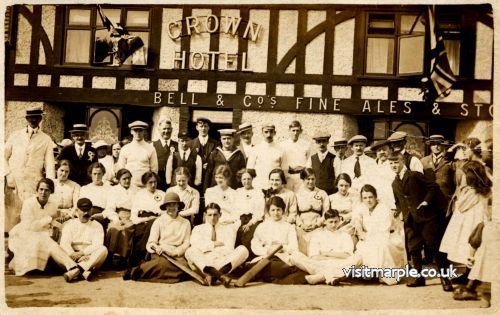
A large group of people outside the Crown at Hawk Green during WW1
Such little stories are what makes a community unique, but like so many others that could have been told they are lost forever, as are the photos, artifacts etc, which are dissipated with time or upon bereavement. For this reason we now have a Residents' Association so it prevails upon us all to record or save anything that might be of interest to our descendants and local historians!
Childhood Memories - The 30s and 40s
We oldies often reflect on the differences in the lives we led as Children & Young Adults. These differences amount to changes in just above everything from the accepted rules of social behaviour through the advent of Television (and the coarsening of media communication) traffic and world travel too and this is my point - the way children occupied themselves either at play or at school. Incidentally during the 40s and early 50s children at most schools ended their studies at the age of 14, so as in my case leaving at the end of the first term after their 14th birthday with the result that even though I was in the “A” Stream I only received 7 or 8 weeks “Education” in my final year and this was with semi-retired old fashioned teachers probably brought out of retirement!
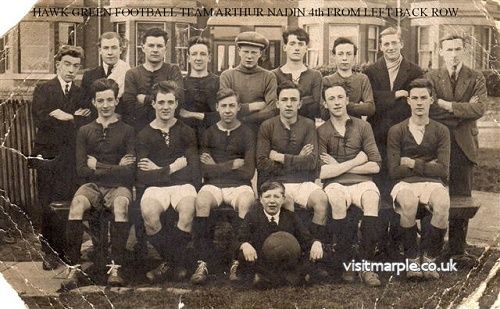
A 1930s Hawk Green Football team
Yes, the prevailing attitudes and mores were very different. However one aspect of the way things were is that children played out far more, wandering all around the local area, the fields, quarries, neighbouring streets, building dens and occasionally a trip to the ‘Roman Lakes’. (Come in No. 7) Where we could use the 'What the Butler Saw' type amusements for a penny (one and a half new pence) After paying 3d (why d. I always wondered as in £.s.d.) to pass through the clicking, multi-barred 7ft high turnstile which I once passed through after being paid two shillings (a florin) for singing in the choir for a wedding at All Saints Church - simple, innocent pastimes indeed and what a contrast to the manner in which people of all ages seek their pleasure in these enlightened times. Yes, the Roman Lakes was the place to be during term holidays and weekends with the un-adopted road to the ‘Mecca’ thronging with people of all ages strolling to and from the attraction. Indeed that splendid Victorian Railway Station on Brabyns (What a loss amongst many!) was always busy with Day Trippers from points up and down the line. The carriages harnessed to a noisy clanking steam engine, probably a tanker, which would top up with water while at the platform which was another point of interest for passengers and train enthusiasts (No anoraks in those days).
I have read that ‘nostalgia kills the spirit’ (or it ain't what it used to be!) However in common with other local wrinklies I reminisce with and on occasion, younger people from whom there is a mixed reaction (a little of which may be scornful and out of earshot) it seems we look back with fondness to those less distracting more carefree times!
An anecdote I'm fond of relating is the occasion when a boy named Roy Cameron (of Sycamore Terrace) whose mother quite openly breastfed a baby in our company. We explored, as we were wont to call our travels, around Barnsfold (Ben Woods Farm) where in the middle of the field we dug up and ate a tuber, which we called a Pignut. What has ever since puzzled me is how did we know what to look for, and was it edible? Well I have mentioned this to many people since and only recently did I meet one person who knew what I was talking about. I cannot remember ever being shown though I have since read an information board by a footpath at Leyburn in Yorkshire which quite matter-of-factly stated that the grazing and wild animals would dig up and eat these nuts. Stating that they displayed a low whitish bloom in late summer, it was not quite late summer and the only white flower I found was clover. All this begs the question since we never hear talk about them and of course the use of pesticides etc. have they, along with much of ancient flora and fauna, disappeared forever? The Pignut of course is what is otherwise known as a truffle and since our French friends look for them with the help of a ham on legs ‘Porker’ though apparently dogs too can be trained, though they are not the preferred choice. However, I wish I knew now where to look! Though I doubt if anyone would tell - could the reader pass on any interesting tit-bits to me, (I'm in the book) about this - or in fact any other stories or artifacts we could include in our Residents Association Historical Records - Remember, if we do not record these things they are gone forever and later generations will be unaware of the way this interesting locality of ours went through the changes.
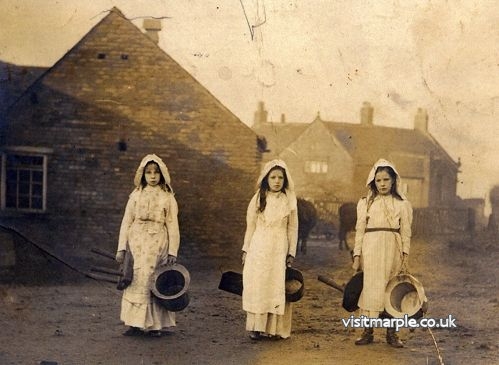
3 maids a milking outside the Manor House, Hawk Green
One pastime for children was Whip and Top with some quite expert displays to be seen from some with a so-called window breaker, which was like a spindle with a flattish top that would fly for yards off the ground - hence the name. This toy, as with Bowl and Hoop needed expertise - hand and eye co-ordination and of course this in turn along with other games would help to train children for other pursuits, unlike the Gameboy! Another game, Hopscotch, was more competitive unlike the previous two, practiced as they were by individuals. This game would be played one to one or by a team but it could result in arguments “You trod on the Line” “No, I did not” etc. Still, that's where we learnt our ‘social skills’, certainly not on a computer sat down in comfort!
Yet another game was Marbles. Played with different rules depending, I think, on which street it was played. The multicoloured glass balls being gathered in numbers by beating an opponent in competition. Again smart practice was sometimes employed! The larger marbles were called ‘Dobbers’ as I recall.
Then again there was Skipping - for the girls - (I never saw a boy with a rope). Showing great dexterity - often reciting chants or rhymes - Salt, Mustard, Vinegar, Pepper was one - you may remember more?
Conkers was another competitive pursuit with the kernels of the horse chestnut tree being threaded onto a string and used to break another that was suspended in turn by your opponent (remember 'stringies' chaps?) The honesty of this game depended on the players since the victor added on the number the loser claimed - all grist for the mill as they say! Latest News (Oct. 2002) a Scout Group in Windsor has been instructed to Ban Conkers for fear of Litigation - What next?
Another trick (game) played by the more mischievous was to tie the door knockers together, retire and watch the fun or if you could afford it regularly phone the same number saying “is Fred there?” When hours or days later ring again saying, “Hello Fred here - any calls for me?”
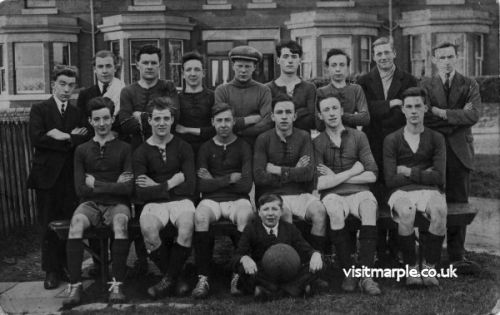
A football team posing with Barnsfold Road, Hawk Green in the background.
Girls would also perform handstands against the walls (encouraged by the boys) and of course cartwheels - in fact from memory I cannot recall the male gender doing any of this type of exercise. One game they would play of course was Tarlio’ or Tick’ where the Player ‘on’ would stand by an object, count say a hundred while everyone else became hidden - the object being to reach the ‘centre’ before the ‘Searcher’ could get back while looking for the others. Tick of course was simply a chase to touch the others - they then would become the ‘chaser’.
Who can remember ‘Hopper’ when with arms folded children would hop into each other? The winner being the one to stay on one leg. Nowadays the Powers that be and probably protective parents would not allow such physical games, ‘Hopscotch’ goodness no – The poor darlings might fall over! Etc.
These and other such games occupied the younger children but nowadays the increasingly streetwise pre-teens would scoff at such pursuits while some perhaps secretly wishing they could engage in less Adult behaviour. Having however piously said all that - we did play ‘Kiss’ and ‘Dare’ behind the cricket pavilion - well, we were a mature 10 - 11 years old!



